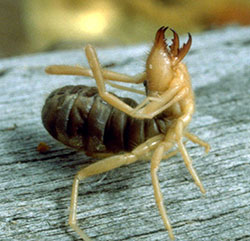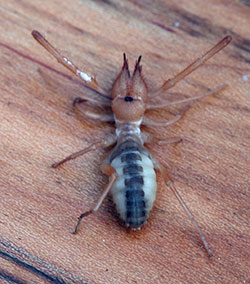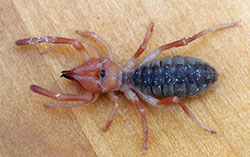by W.S. Cranshaw*, Paula Cushing*, and Jack Brookhart* (3/17)
Quick Facts…
- Windscorpions are a type of arachnid native to many of the drier areas of Colorado below 7500 feet. Fifteen species are known to be present in the state.
- Other common names for windscorpions include “sunspiders”, “solifuges”, “solpugids” and “camel spiders”.
- Windscorpions are active at night and feed on insects. Rarely, they may incidentally enter buildings.
- Despite their bizarre displays, windscorpions are harmless to humans.

Figure 1: A windscorpion, also known as a “sunspider” or “solpugid” |

Figure 2: A windscorpion in a defensive posture. (Photograph courtesy of Eugene Nelson, Colorado State University) |

Figure 3: A windscorpion, Eremobates pallipes |

Figure 4: A windscorpion, Emerochelis bilobatus |
Windscorpions are animals of bizarre appearance that can be found in most of the drier areas of Colorado below 7500 feet. These are a type of arachnid, categorized in the order Solifugae, and are distant relatives of “true” scorpions (order Scorpiones) and spiders (order Araneae). Other common names given to windscorpions include “sunspiders,” “solpugids,” “solifuges,” and, “camel spiders.” Presently 15 species are known to occur in Colorado (Table 1).
Physical Features of Windscorpions
Like other arachnids, two main regions comprise the body of a windscorpion. In the front is the prosoma, which includes the head area with its massive jaws (chelicerae). Five pairs of appendages are also present on the prosoma: four pairs of legs and, at the front, the pedipalps.
In windscorpions the pedipalps superficially appear as a fifth pair of legs, but have many functions. Most of the sensory organs are found on the pedipalps, allowing them to detect vibrations and, probably, odors. Other sense organs, called malleoli, are found on the hind pair of legs. These structures are shaped like leaves and function to pick up chemical cues in the environment. The pedipalps also may be used to help capture prey, climb, and dig.
The hind body region, known as the opisthosoma (or abdomen), lacks any appendages, is generally rounded and soft. Overall coloration of most windscorpions is light brown or reddish brown, with the opisthosoma often predominantly gray or cream colored. Full-grown the windscorpions found in Colorado may reach 1 1/2 inches long, with legs extended. (Species found in the Middle East are known to reach a bit over 4 inches.)
Life History and Habits
Windscorpions are predators that eat small insects and other arthropods. Species found in Colorado hunt at night, locating prey by touch or vibrations. They are capable of fast movement and can run down most prey. Pads on the pedipalps can help pull in prey to the body. They are then grasped with the large, pointed jaws which can twist, cut and crush. Mixed with saliva, prey are reduced to liquid via external digestion.
During the day windscorpions hide under or in all manner of items, including rocks, boards, logs, cow chips, rodent burrows, and the stalks of plants. Burrows in soil may be produced, and can provide temporary shelter or protection during periods when they molt. Burrows are also used by females when laying eggs.
Females lay their eggs in masses of 50-200 eggs, typically in late summer. It is thought that females only produce a single mass of eggs and die shortly after the eggs are laid. Eggs hatch in 1-2 weeks and the newly hatched young are whitish and helpless. After the first molt, they darken and become more mobile. They remain clustered within the burrow for a couple of weeks. Upon molting again, they leave the burrow and begin to hunt for prey. With favorable conditions for growth they will continue to grow and develop, molting several times before reaching the adult form. A one year life cycle is presently assumed to be normal for the windscorpions that occur in the state.
Windscorpions and People
Despite their large jaws, bizarre appearance, and threatening displays of defense, windscorpions in Colorado are harmless to humans. They do not have poison glands, do not attack, and bite only if accidentally restrained. In the rare instance where they do bite, they produce no more than a mild pinch and cannot break the skin.
Windscorpions will occasionally enter homes and buildings, particularly in mid to late summer. This occurs infrequently, when individuals happen to incidentally find crevices and entry points as they forage for food at night. Outdoor lighting that illuminates areas near a building foundation, may often contribute to the incidence of windscorpions being found indoors, as they search for insects that may be attracted to nighttime lighting. Reduction of outdoor lighting and caulking/sealing crevices around windows and other entry points near ground level should be exclude most windscorpions from buildings.
Windscorpions can make interesting and unusual, but shortlived, pets. Larger, mature individuals will likely survive only a couple months (at the most) in captivity, with females being longer lived than males. Terrariums should have a sand base with a few rocks or other materials for cover. A small water source, such as a moistened wad of cotton, should be provided. The top of the terrarium should be covered to prevent escape from climbing. Mealworms or small crickets are good foods to provide windscorpions in captivity.
Table 1. Checklist of the Solifugae (windscorpions, sunspiders) known from various areas of Colorado (2014).
| Front Range Eremobates pallipes Eremobates palpisetulosus Eremobates bantai Eremorhax mumai Eremochelis bilobatus Hemerotrecha fruitana Hemerotrecha cornutaSan Luis Valley Eremobates similis Eremochelis bilobatus Hemerotrecha fruitana Northwest Corner Colorado Plateau (Colorado National Monument) Southwest Corner |
*Whitney Cranshaw, Extension Specialist of Entomology, Colorado State University. Dr. Paula Cushing and Jack Brookhart, Zoology Department, Denver Museum of Natural History. 3/99. Revised 3/17.
Go to top of this page.





